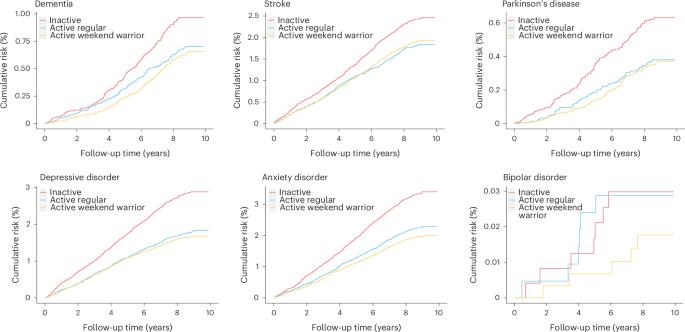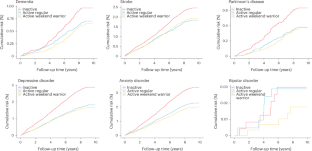Accelerometer-derived ‘weekend warrior’ physical activity pattern and brain health
IF 17
Q1 CELL BIOLOGY
引用次数: 0
Abstract
Extensive evidence shows the beneficial effect of adhering to a regular physical activity (PA) pattern on brain health. However, whether the ‘weekend warrior’ pattern, characterized by concentrated moderate-to-vigorous PA (MVPA) over 1–2 days, is associated with brain health is unclear. Here, we perform a prospective cohort study including 75,629 participants from the UK Biobank with validated accelerometry data. Individuals were classified into three PA patterns using current guideline thresholds: inactive (<150 min week−1 of MVPA), weekend warrior (≥150 min week−1 with ≥50% of total MVPA occurring within 1–2 days) and regularly active (≥150 min week−1 but not meeting weekend warrior criteria). We find that the weekend warrior pattern is associated with similarly lower risks of dementia, stroke, Parkinson’s disease, depressive disorders and anxiety compared to a regularly active pattern. Our findings highlight the weekend warrior pattern as a potential alternative in preventive intervention strategies, particularly for those unable to maintain daily activity routines. Research suggests that exercise has a beneficial effect on brain health during aging but more information is needed. Here, the authors show, using UK Biobank data, that the ‘weekend warrior’ physical activity pattern, with concentrated exercise over 1–2 days, is similarly linked to lower risk of brain disorders compared to regular exercise.


加速度计衍生的 "周末战士 "体育活动模式与大脑健康。
大量证据表明,坚持有规律的体育锻炼(PA)模式对大脑健康有益。然而,"周末战士 "模式的特点是在 1-2 天内集中进行中等强度的体育锻炼(MVPA),这种模式是否与大脑健康有关尚不清楚。在此,我们进行了一项前瞻性队列研究,研究对象包括英国生物库中 75629 名拥有有效加速度测量数据的参与者。根据目前的指南阈值,我们将参与者分为三种运动模式:不活跃(-1 的 MVPA)、周末战士(每周-1 的运动量≥150 分钟,其中≥50% 的总 MVPA 发生在 1-2 天内)和定期运动(每周-1 的运动量≥150 分钟,但不符合周末战士标准)。我们发现,与经常活动的模式相比,周末战士模式与痴呆症、中风、帕金森病、抑郁症和焦虑症的风险同样较低。我们的研究结果突出表明,周末战士模式是预防性干预策略的潜在替代方案,特别是对于那些无法保持日常活动习惯的人。
本文章由计算机程序翻译,如有差异,请以英文原文为准。
求助全文
约1分钟内获得全文
求助全文

 求助内容:
求助内容: 应助结果提醒方式:
应助结果提醒方式:


